After a difficult start to the season, Manchester City Women have seemingly found their confidence again, with four consecutive WSL wins and a place in the Continental Cup quarter-finals bringing the feelgood factor back to the Academy Stadium. However, the main reason that head coach Gareth Taylor will be happier now is that the majority of players who were injured earlier on in the campaign are now back in the matchday squad, with captain Steph Houghton, right-back Lucy Bronze, midfielders Keira Walsh and Caroline Weir and forward Hayley Raso all featuring during their last run of matches.
Despite this, the continued absence of former Everton Women forward Chloe Kelly has led to the need for another right-sided attacker to come in this season, and 21-year-old Jess Park is one player that Manchester City seem to have turned to. Park doesn’t have too different a playing style to Kelly, as both like to create chances, put in dangerous crosses and get behind opposing defences, so she has fitted into Gareth Taylor’s tactics well. With that in mind, this tactical analysis will delve deeper into how her inclusion has helped Manchester City, allowing them to pose more of a threat and generally play with more belief.
Creating options
The first thing to look at in this scout report is how Jess Park creates options, with her natural instinct being to locate and move into open spaces when possible.
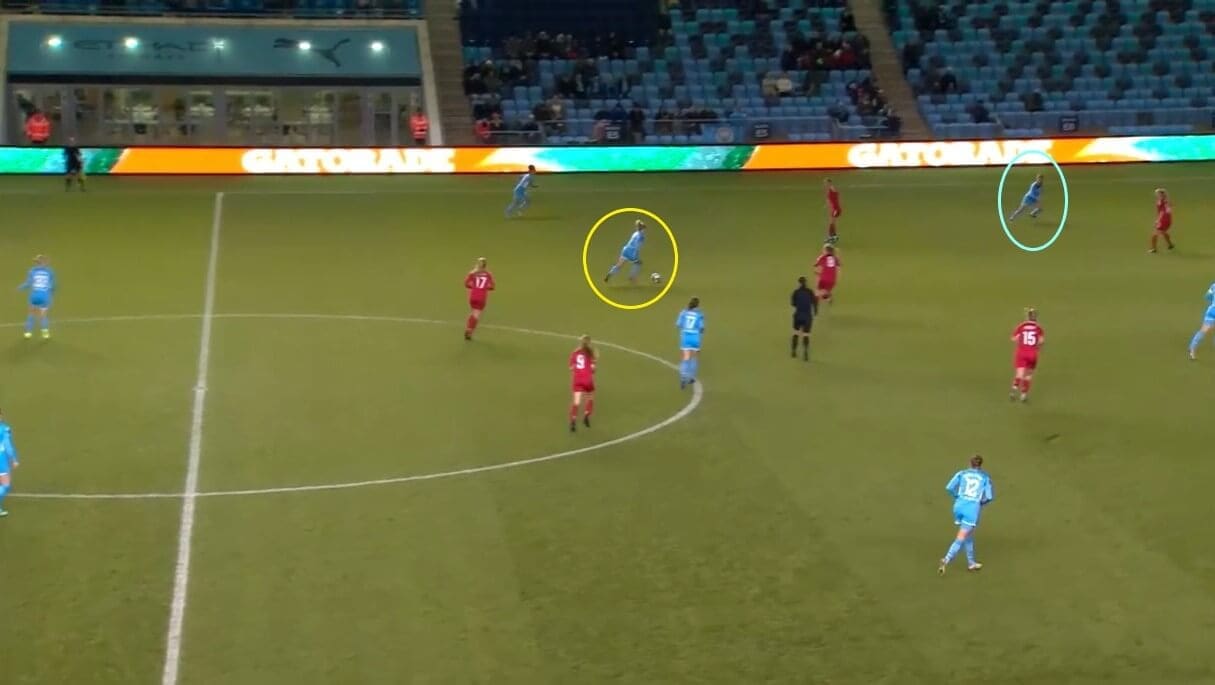
A key aspect of Gareth Taylor’s tactics has always been to build from the back when in possession, either through dribbling into the opposition’s half or by playing through the thirds, but this has not always been possible this season, due to opponents sitting back and frustrating them.
However, having Park in the team has enabled Manchester City to play through defensive lines on more occasions, for two reasons. Firstly, she makes runs behind opponents that give teammates passing options in open spaces, and the fact that Durham Women captain Sarah Wilson’s interception was the only thing that stopped the ball reaching Park shows how Manchester City have been more threatening with her in the team. Secondly, by keeping her distance from the ball, Park has prevented Durham from completely surrounding it, therefore making it easier for her team to play through them.

This image shows Park making another run behind the opposing line, but in a different situation. This time, Manchester City have formed a triangular structure, which is a popular setup to have in attack, as it enables teams to move the ball through defenders quickly. We haven’t seen it being used so much this season by Gareth Taylor’s side though, as they haven’t had the players available to make it work. However, now that Bronze is back, Manchester City have a natural attacking right-back who can work with teammates to move the ball through gaps, creating more chances.
In order to turn these situations into efforts on goal, Park has again looked to run behind the Aston Villa Women players, helping the ball to keep moving forwards. Therefore, again, she has been a key part of their upturn in form, with her anticipation around the pitch a key feature of her team’s attacking play.
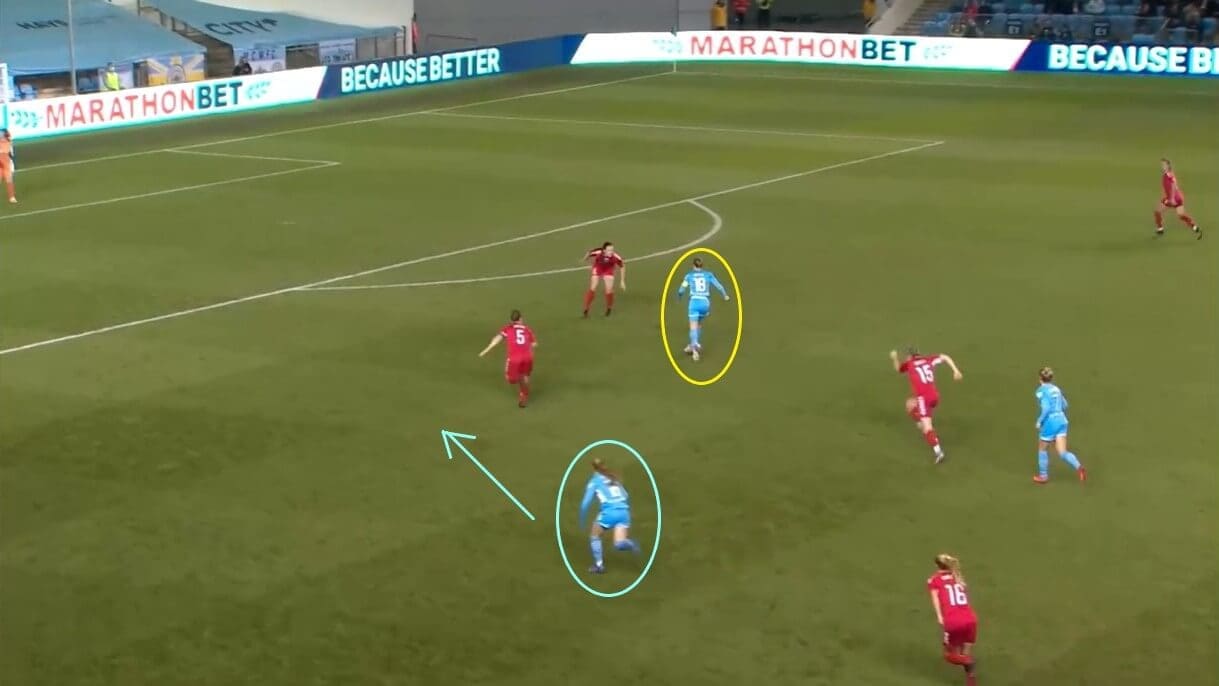
It is not only when the ball is ahead of her that Park gets forward, with this image showing England striker Ellen White in possession at the top of the pitch. White likes to lead the line and give her team a constant presence in the final third, but Durham have surrounded her here and limited her options. Park is aware of this, running forward to provide a passing option for White and giving Manchester City a way of moving the ball out of this congested area of the pitch, and this once again demonstrates her ability to position herself where she can help her team.
This support was something that Manchester City lacked earlier on in the season, with players often left on their own without any teammates near them, and this was a key reason that a lot of their attacks broke down. However, Park has changed that, with her runs behind defences and in support of teammates enabling the ball to keep moving forwards, as well as making it harder for opponents to win the ball. As a result, more of their attacks have ended in goals, which has been a key reason for the team’s improved form, and this is why Park has been so important for them with regards to this part of their game.
Versatility
The second thing we need to look at in this analysis is Jess Park’s versatility. Normally, this would revolve around focusing on her ability to play both on the wing and through the middle, but Park is a different type of winger, making her a more unpredictable player to face.
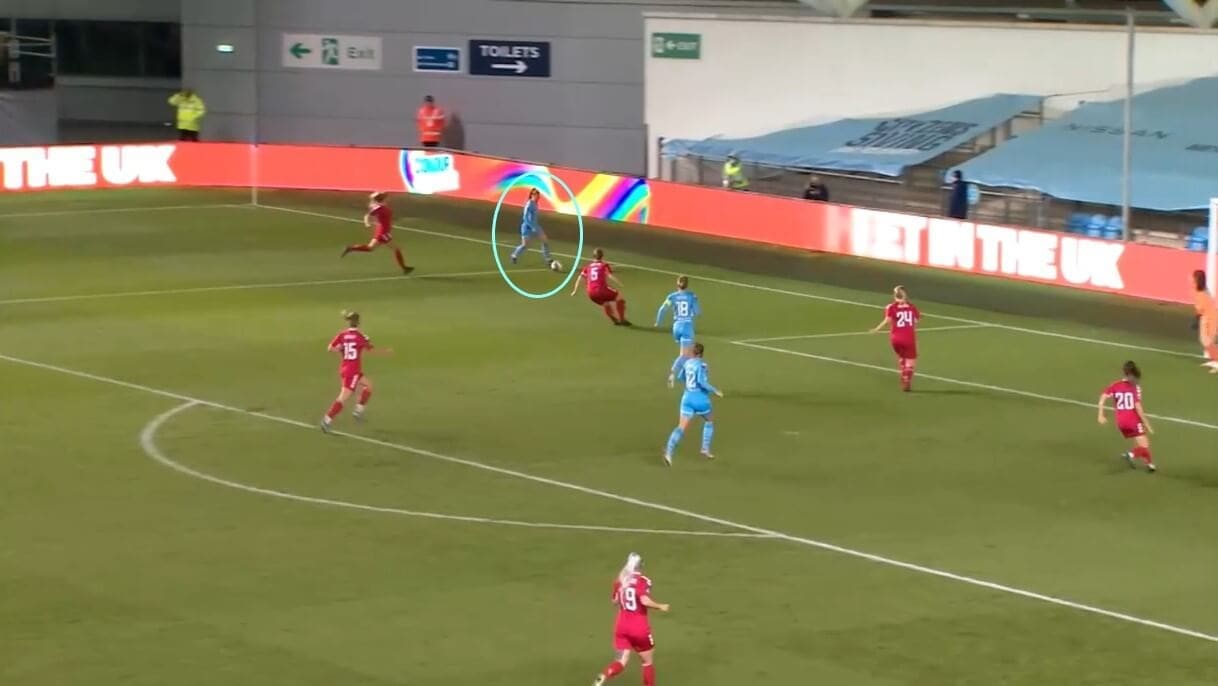
We know already that she likes to get behind opposing defences, but this is where her ability with the ball comes in. Wingers need to be good at crossing balls into the box and setting up chances, given that it is their main job in football games, but Park is also able to time when she sends the ball in, depending on what is happening in the goal area. When her team want to take opposing defenders by surprise, she can play the ball in early, but she can also hold onto the ball and be patient when space is congested and her teammates can’t give her a good target to find.
In this example, Durham have got back well to limit the space, so Park takes the ball towards the goal line instead of crossing the ball in and risking Durham clearing their lines. She is comfortable in tight spaces, and having her on the wing has allowed Manchester City to play to their tempo and not their opponents’, which is another difference between now and earlier in the season.
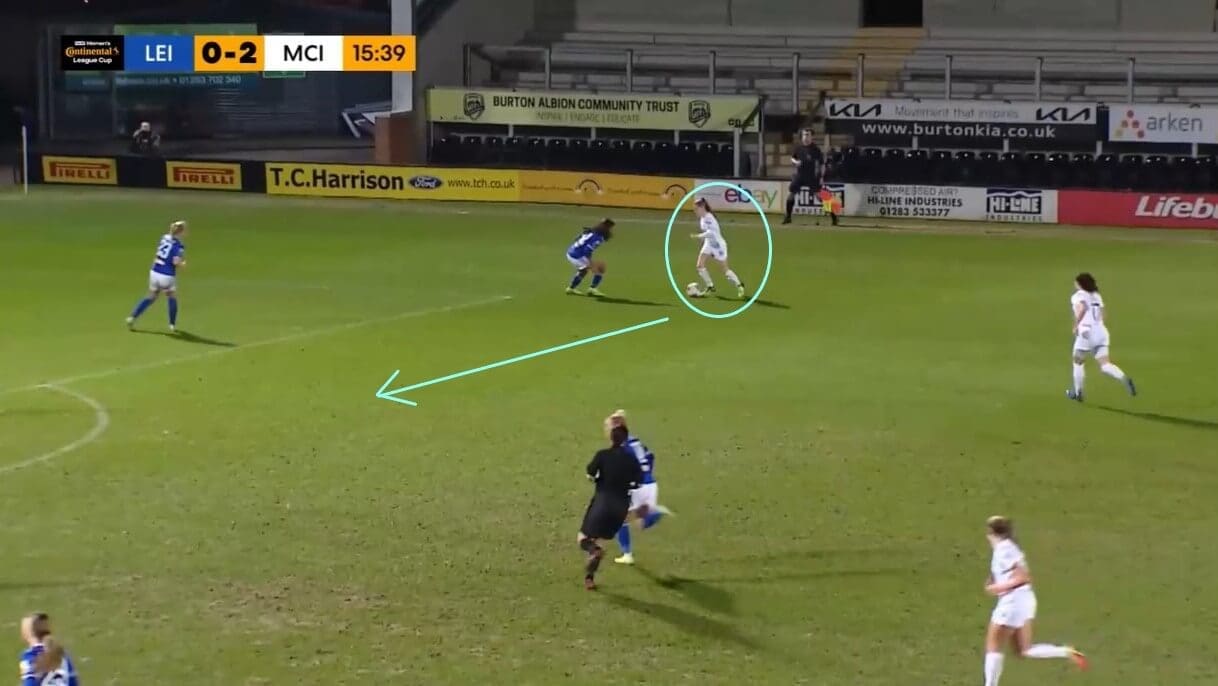
Park played mostly as a striker before joining Manchester City Women in 2017, and that means that she is comfortable at cutting inside and playing in central areas too. Here, she again shows patience on the ball, waiting for Leicester City Women debutant Ava Baker to run behind her before changing the direction of her run, catching Leicester out and getting her into a better area to assess what is going on around her, once again enabling her to pick the right pass.
In this Continental Cup match, Park set up a trio of goals and picked up the Player of the Match award, and that was the result of her wanting to make things happen, rather than holding onto the ball and waiting for her teammates as she did in the previous example. Therefore, she is capable of adapting to different systems and styles of play, which is another reason that Manchester City have come to see her as a good fit whilst Chloe Kelly continues her recovery from injury.
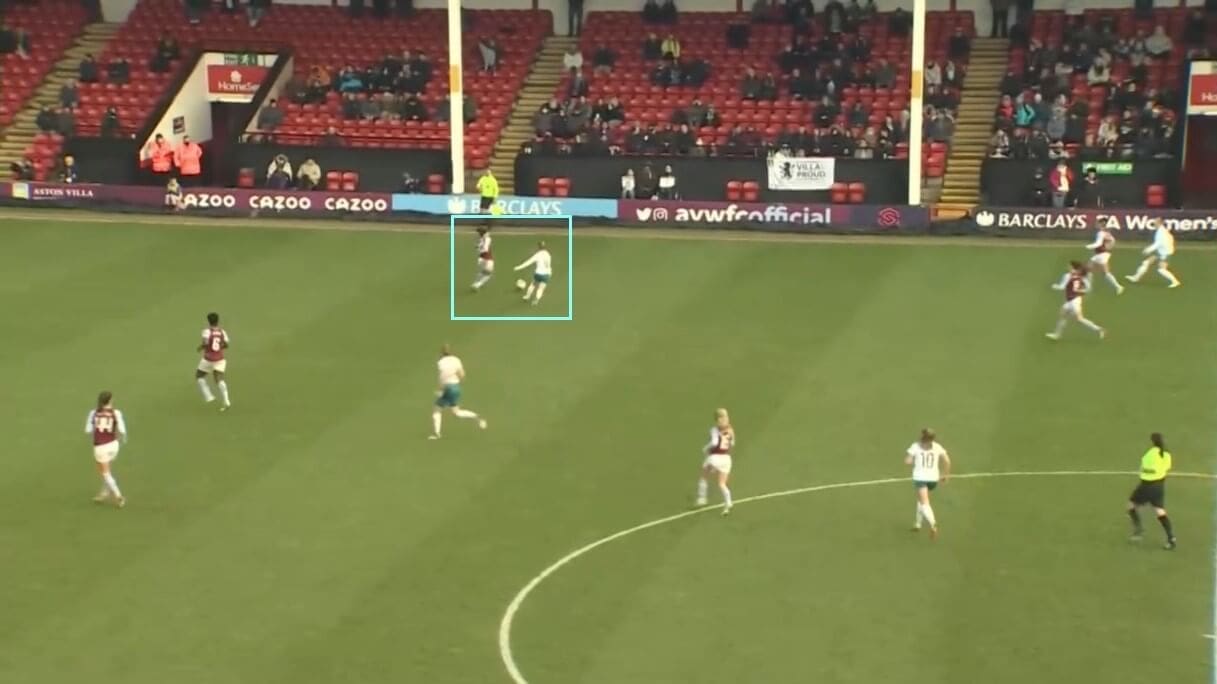
When Manchester City are out of possession, the forwards become their first line of defence, and Park is also able to perform this role too. Here, Aston Villa’s former West Ham United Women left-back Maz Pacheco has the ball, but Park has stayed close to her, preventing Pacheco from playing forwards. In doing so, she has stopped Aston Villa from counter-attacking whilst Manchester City are out of position, giving her teammates time to set themselves up and close off any open spaces, ensuring that they have a better chance of ending the attack before the ball gets too close to their goal area.
It is also worth noting that Park has made 29 interceptions this season in all competitions, so Pacheco knows that playing forwards would risk her team losing possession. As a result, her only option becomes passing sideways to either on-loan Arsenal Women defender Anna Patten or former Chelsea Women player Anita Asante. This again benefits Manchester City, as White can now move towards those players and put pressure on them, hoping to regain possession. Therefore, defending as well as attacking has been improved through having Park in the team.
Link-up play
This scout report has so far focused on how Jess Park has played a key role in Manchester City Women’s attacking and defensive play through her ability to create options and her versatility, but the final part of her play that needs looking at is how she links with teammates around the pitch, again leading to the recent improvements in their play.
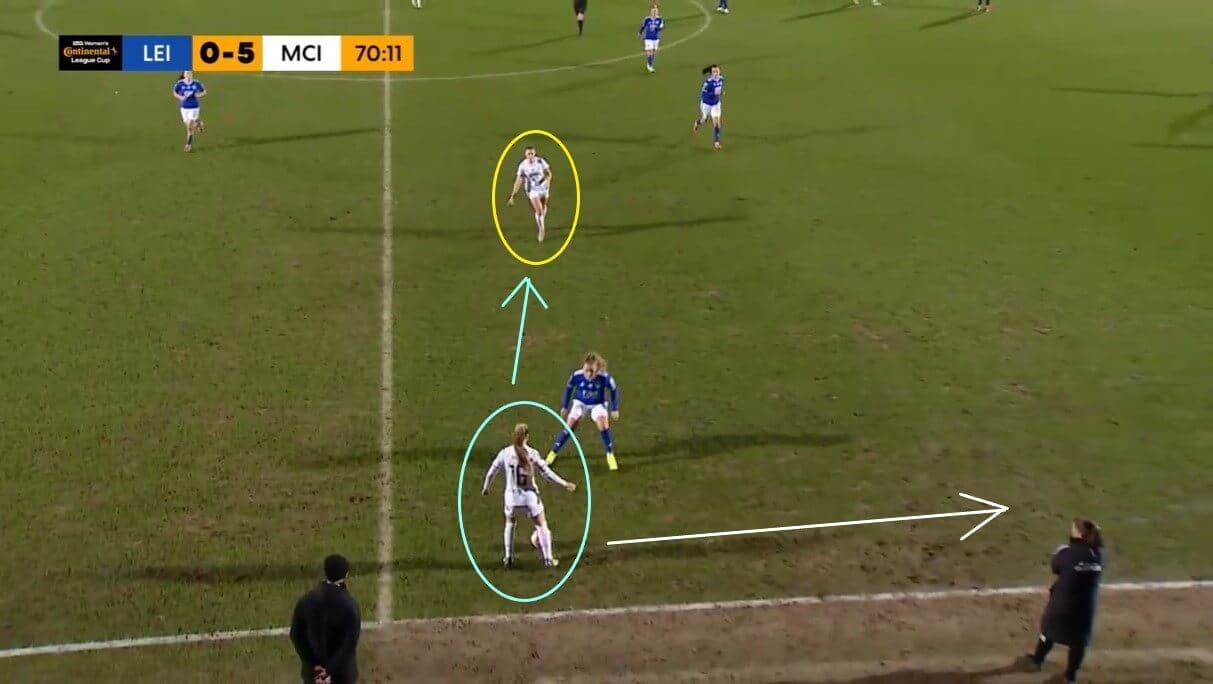
We have mentioned already that Park is comfortable when playing in tight spaces, and this image again shows her close to the line. This time, she needs support, which comes in the shape of Georgia Stanway, and this creates a 2-v-1 situation which enables Park to pass the ball out and instantly run forwards to give Stanway the option of a return pass in the open space ahead.
Although this option is not taken, with Stanway instead turning and taking the ball inside the pitch, this situation still demonstrates how Park’s speed has been key to Manchester City maintaining possession, even when it looks like they have been forced into a corner. Park’s passing accuracy this season currently stands at an impressive 81.5%, so having her on the pitch has improved her team’s chances of keeping the ball in tight situations like this one, when, previously, they would have struggled to find a way out.

She can also play further inside the pitch when others have control of the wing, and this is where another of Manchester City’s key tactics from last season comes in. Gareth Taylor tended to task the outside central midfielders with playing in the half-spaces, and USA midfielder Sam Mewis, now with NWSL side Kansas City Current, proved to be particularly adept at this, whilst Manchester City as a team became harder to play against, due to the fact that they effectively had five players in the final third when attacking.
However, with Mewis gone and Lucy Bronze back on the pitch, it seems that Park has, on occasion, been asked to take up this role, with her positioning here taking the Aston Villa players’ focus away from Bronze, who has come up the pitch to support the attack. Therefore, again, she has worked with her teammates to create an attacking opportunity, although this is perhaps an example of indirect link-up play.
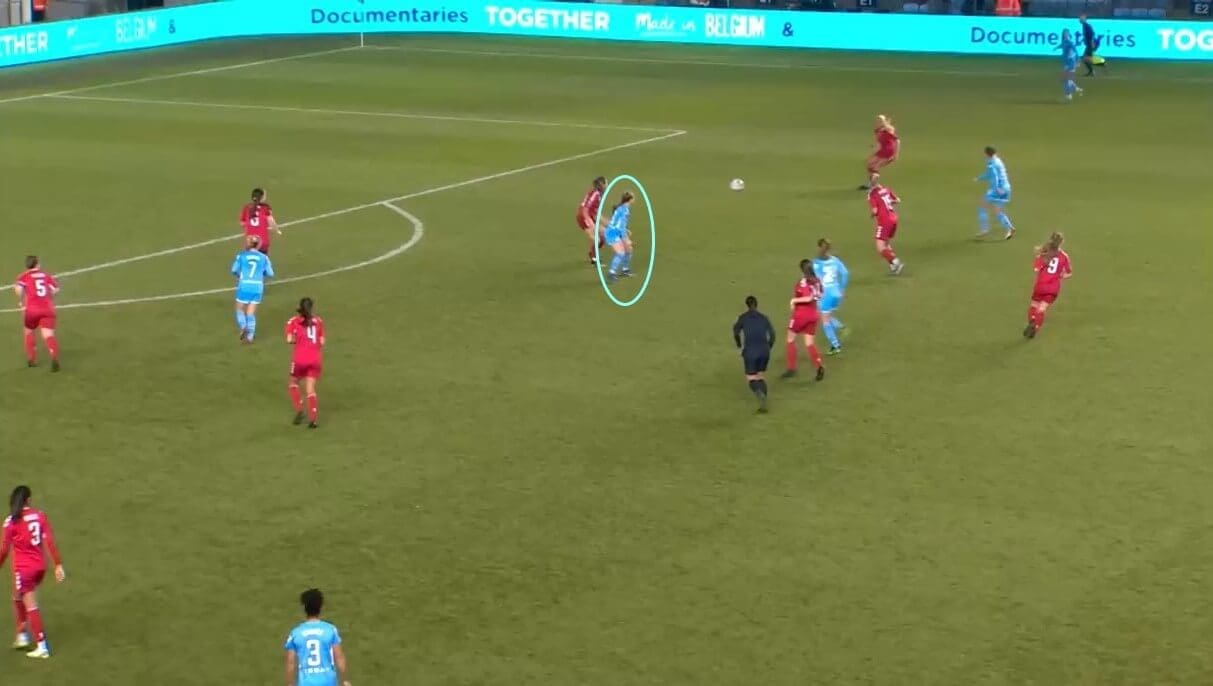
When not on the wing or in half-spaces, Park can also be found in the middle of the pitch. However, she doesn’t look to get into the box and score goals on many occasions, hence her goal tally of just one this season, but instead tries to play her part in Manchester City moving the ball into different areas of the pitch. In this way, she acts as a pivot in their attack, again helping them to move the ball out of tight spaces and into areas where chances can be created. This is another way that Manchester City have managed to turn previously difficult situations into ones where they are now shooting and scoring goals, and Park’s inclusion in the team in recent games has undoubtedly aided that development in their play.
Conclusion
In conclusion, this tactical analysis has looked at why Jess Park has become such a key player for Manchester City Women this season, and “a real threat” according to Gareth Taylor. We have looked at how she creates options in attack for her side, why her versatility and ability to adapt to different match situations has benefitted her team, and why her link-up play has helped Manchester City to be more attacking and cause more problems for their opponents. With Chloe Kelly’s return date still unknown, it is highly likely that she will continue to feature in the team, and an extended run of starts whilst continuing to play at this level may well lead to an England call-up in the future as well.





Comments